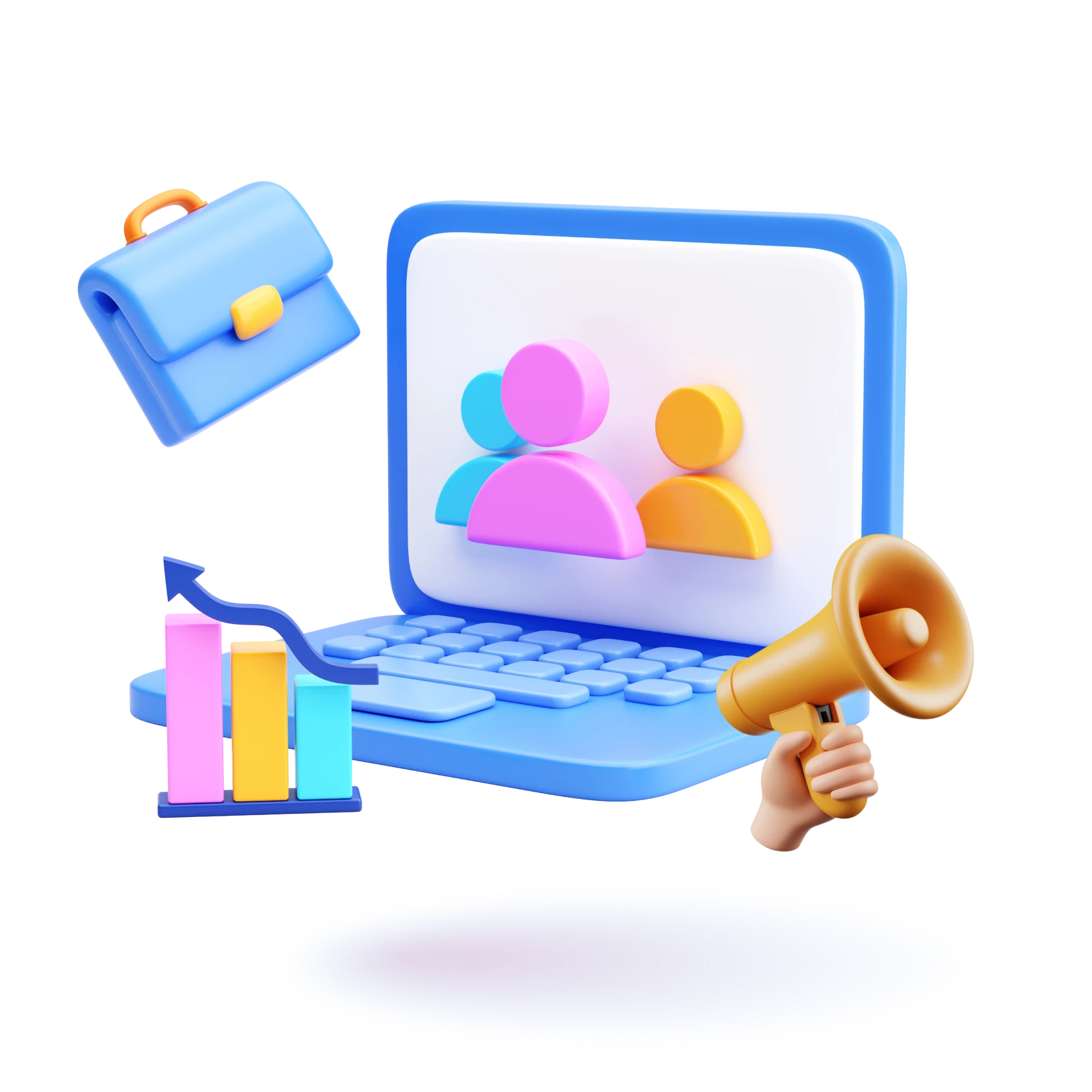There was a campaign early in my career that I still think about often—not because it fell flat, but because it took off faster than any of us expected. It was the same team, client, and product. But the difference? This time, we nailed the strategy.
We launched on Monday morning. By Wednesday, the client called and asked if we could pause outreach—his sales team couldn’t handle the volume. By Friday, his calendar was packed with high-quality calls from the exact companies he wanted to close.
We didn’t spam a thousand inboxes or bribe people with gimmicks. We pinpointed a real pain point, tailored the message to the decision-makers, and delivered it through the channels they checked. That week, I realized something fundamental about generating sales leads: not how many messages you send. It’s about who you send them to, why it matters to them, and how you show up in their world.
So, if you’re wondering how to generate sales leads that convert, forget the shortcuts and focus on what works.
Know Exactly Who You’re Talking To
One of the biggest mistakes I see is teams jumping straight into outreach without knowing who they’re trying to reach. They lead with the offer, the pitch, the CTA because that’s what’s urgent. But if you skip defining your audience, even the strongest message is noise.
I’ve seen it play out. We once ran a campaign that seemed airtight—great visuals, solid subject lines, clean copy. But the results were underwhelming. Conversions flatlined. The issue? Our targeting was way too broad. The messaging wasn’t wrong; it was in the wrong inboxes.
In contrast to a SaaS project we ran for a client in the logistics space, we didn’t just say, “Let’s target logistics companies.” We narrowed it down to mid-sized firms still relying on outdated tracking tools and shipping across multiple regions.
That specificity allowed us to craft pain-point-driven messaging—a crucial difference when it comes to generating leads in sales that convert. Suddenly, our emails didn’t feel like cold outreach—they felt relevant.
So, how do you get there? You start by building your Ideal Customer Profile (ICP). Think of it as your blueprint:
- Firmographics: Industry, company size, location, and annual revenue.
- Technographics: What tools are they using (or not using), and how do they impact their workflows?
- Role-based Targeting: Who feels the pain your product solves? Is it the Head of Ops, a VP of Sales, or a CTO?
- Behavioral Traits: Buying cycles, decision-making structures, common objections, content engagement patterns.
Understanding your ICP is the foundation for generating leads in sales, especially when paired with tailored buyer personas. The connection happens naturally when your outreach reflects their goals and language.
Why does this matter? Because 70% of B2B marketers who exceed their lead goals have documented buyer personas. When you know who you’re talking to, you stop guessing. You stop wasting time chasing the wrong people, and instead generate leads for sales that are far more likely to convert.
Here’s a simple framework we use when reviewing targeting:
- “Would this person benefit from our product right now?”
- “Can they make or influence the decision?”
- “Have we spoken to someone like this before and closed?”
If the answer isn’t “yes” across the board, the lead might not belong in the campaign.
So no, your outreach shouldn’t start with what you’re offering. It should start with who you’re talking to. Nail that—and everything else gets easier.
Multichannel Outreach Isn’t a Trend
If you only use one channel to reach leads, you leave money on the table. Prospects no longer live in their inbox—they bounce between LinkedIn, Slack, email, phone, internal meetings, and five browser tabs. Your outreach has to reflect that.
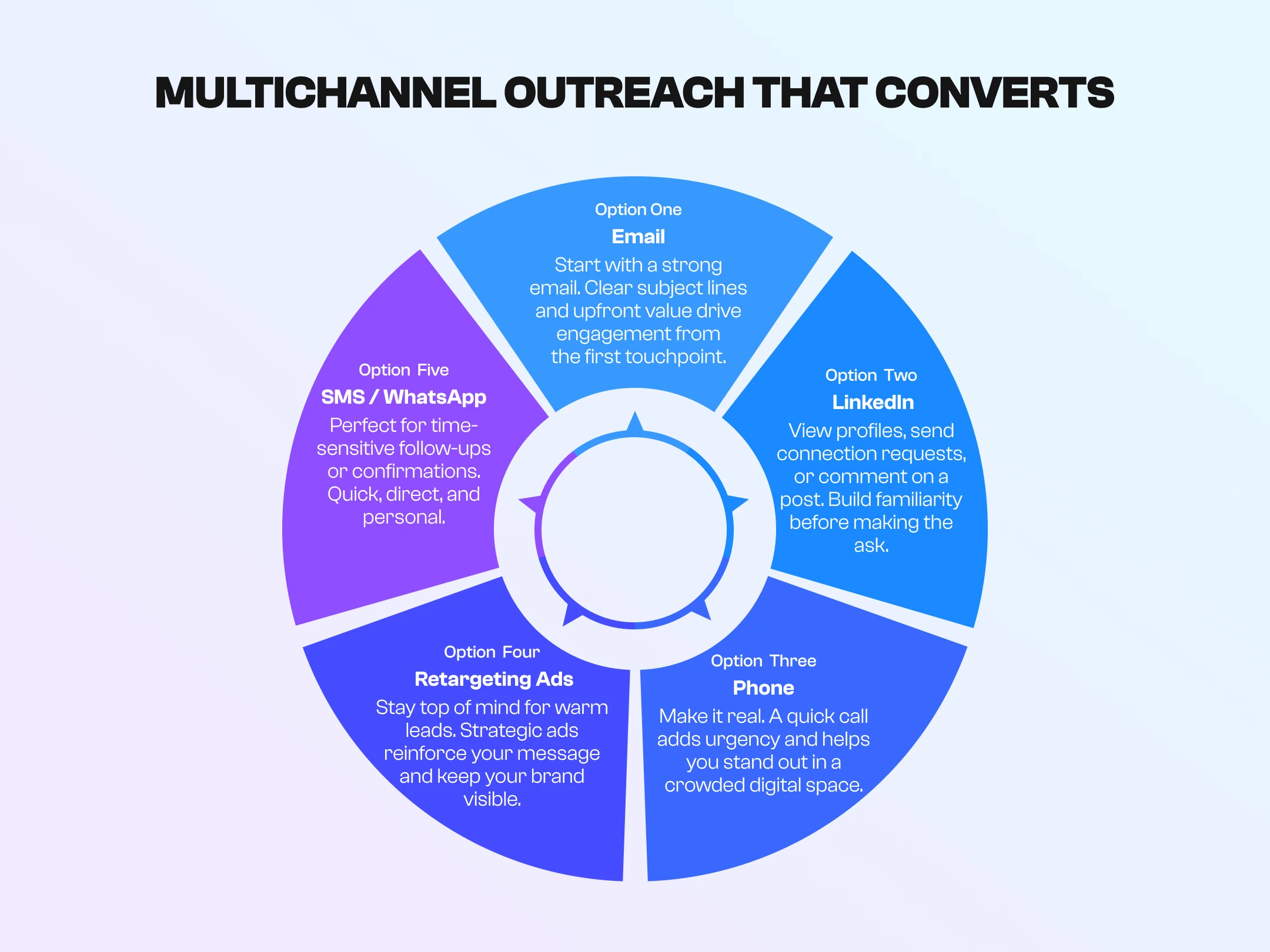
Here’s what works:
- Email is great for the first touch, especially with a clear subject line and value right up front.
- LinkedIn builds familiarity. A simple profile view or connection request warms them before the message lands.
- Phone calls create urgency. Hearing an authentic voice breaks through the digital noise.
- Retargeting ads can keep your brand at the top of your mind, especially for high-intent leads who have engaged but not responded.
- SMS or WhatsApp (where appropriate) works well for last-step reminders or confirmations.
Companies using 3+ channels see a 287% higher conversion rate. That’s not just about being everywhere—it’s about staying relevant through multiple, coordinated touchpoints.
Multichannel doesn’t mean blasting people everywhere at once. It’s a structured, intentional approach—proven essential for generating leads in sales environments where attention is fragmented. Map it to your average sales cycle. Know when your audience is most active and build around that.
I had a client—smart founder, solid product, strong value prop—who relied entirely on cold email. At first, it seemed reasonable—email is scalable, cost-effective, and measurable. But the campaign was stalling. Open rates were okay, replies were sporadic, and booked meetings were lower than expected.
We reviewed everything: subject lines, copy, cadence. Then I asked, “Where else do your prospects spend time?” He hesitated. That was the moment things started to shift.
We layered in LinkedIn profile views, connection requests, personalized messages, and followed up with strategic cold calls. Not to pitch, but to introduce, reconnect, and build trust. Within a week, we were hearing the same thing from prospects:
- “Oh, I’ve seen your name. You emailed me, right?”
- “That LinkedIn post made me curious.”
- “Glad you followed up—I meant to respond.”
It wasn’t magic. It was consistency.
The mistake many teams make is treating outreach like a single-threaded effort. But today’s buyers are juggling inboxes, meetings, Slack messages, and five tabs simultaneously. To generate leads for sales, your message has to meet people where they are—across LinkedIn, email, phone, and more.
Multichannel outreach is one of the most effective ways to generate leads for sales. It’s how people consume information now. If you’re only using one channel, you’re not just limiting your reach—you’re betting on attention spans that don’t exist anymore.
The Day I Learned Personalization Isn’t Optional
Let’s clarify: no one wants to feel like email #487 in a sequence. People respond to relevance, not volume. We learned the hard way on a SaaS campaign where our messaging was strong, but our personalization was weak.
Here’s what we changed to turn it around:
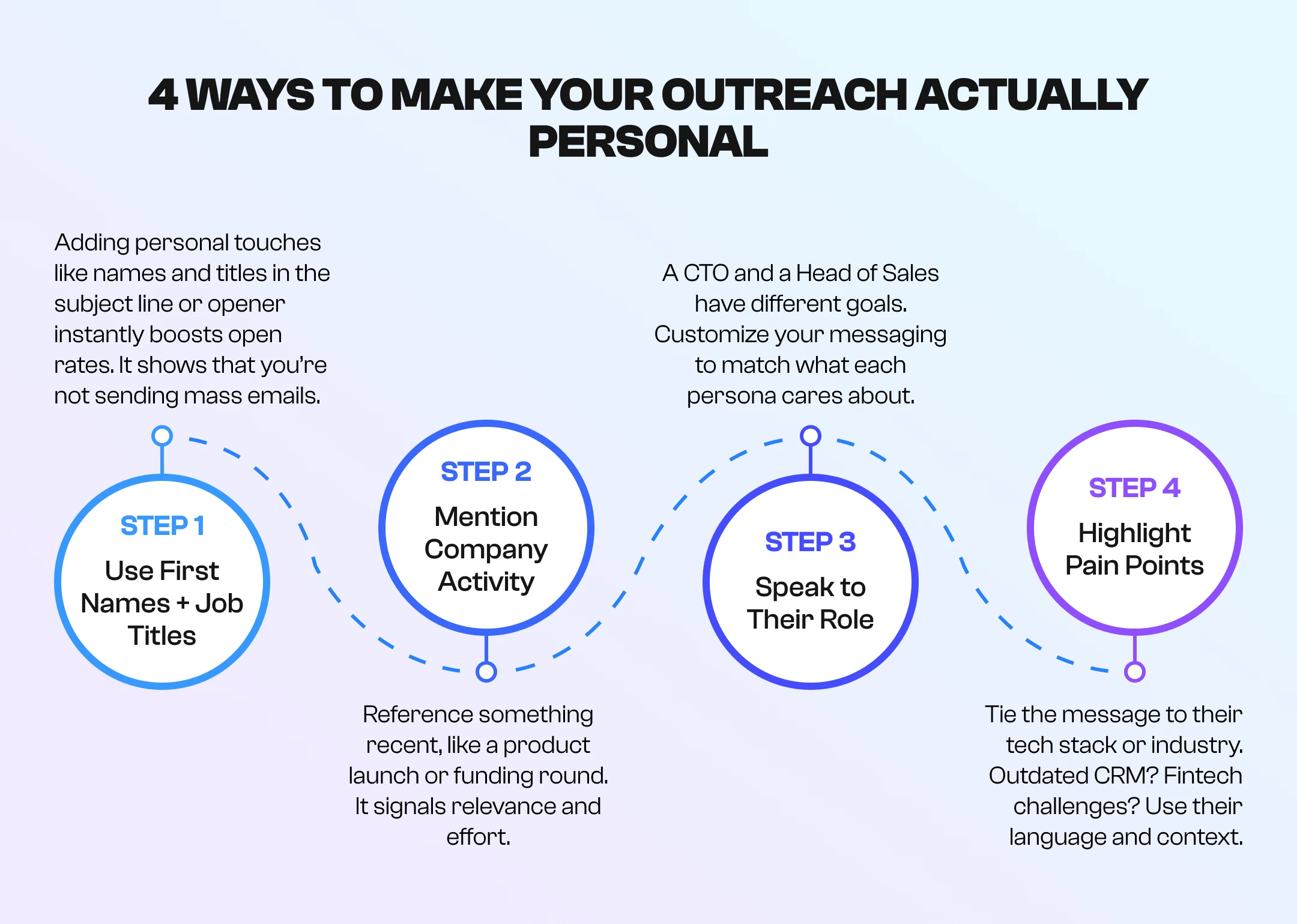
- Used first names and job titles in the subject line or opening sentence. Open rates went up immediately.
- Referenced the company’s recent activity, like a product launch or funding round, showing we did our homework.
- Spoke directly to their role. A CTO doesn’t care about the same thing as a Head of Sales. Messaging must reflect that.
- Included pain points specific to their tech stack or industry. If they’re using outdated CRMs, mention that. If they’re in fintech, speak their language.
For example: “Saw you’re using HubSpot—how’s your team managing lead handoff between marketing and sales?”
That slight shift—tying your message to them—is how you move from broadcasting to truly generating leads in sales.
Personalized emails deliver 6x higher transaction rates. That’s not fluff. That’s data.
In that campaign, once we dialed in the details, reply rates went from under 5% to nearly 15%, and meetings tripled. It’s the same product—just more human communication.
So if you’re still sending “Hi there” emails—stop. Treat every lead like a real person, not a data point. That’s where conversions start.
Why Lead Magnets Still Work
One client I worked with was hesitant to “give away value.” He felt that offering a free eBook or toolkit would cheapen the brand or give competitors a peek behind the curtain. His mindset was that people should pay for it if it’s valuable.
But here’s what changed his mind.
We created a simple 8-page eBook—nothing fancy, just clear insights on solving a specific operational issue that his target audience faced. We added a lead capture form and promoted it through LinkedIn and email, and within two weeks, he had over 200 qualified leads, most from companies he’d been trying to reach for months.
That’s the power of a lead magnet.
People don’t give you their email because they like your brand. They give it because you solved a problem, saved them time, or gave them an “aha” moment. Value first. Trust later. Business follows.
Companies with strong content offers generate 67% more monthly leads than those without. That’s nearly double the pipeline, just from leading with something useful.
Here’s what makes a great lead magnet:
- It solves a real, narrow problem. Don’t go broad—go specific. “How to cut churn in SaaS” beats “10 ways to grow a business.”
- It’s instantly usable. Templates, checklists, cheat sheets, calculators—people love tools they can apply immediately.
- It’s easy to digest. Think 5–10 pages max or a 2-minute tool. No one wants a novel.
If you’re still wondering how to get sales lead traction without sounding salesy, lead magnets are your answer. They’re just often done wrong. When done right, they open the door—and they do it without a cold pitch.
Social Proof That Sells for You
I once had a prospect who ignored every email we sent—zero replies. Then, out of nowhere, he booked a meeting through the website. On the call, I asked what had changed. His answer? “I read your case study with [Client Name]. It felt like you were already solving my problem.”
That’s when it hit me: sometimes it’s not your SDRs or subject lines doing the heavy lifting. It’s your happy clients.
92% of B2B buyers are more likely to purchase after reading a trusted review. That’s huge. And it means your case studies, testimonials, and third-party reviews quietly work in the background, closing deals while you sleep.
Here’s how to make social proof do the selling for you:
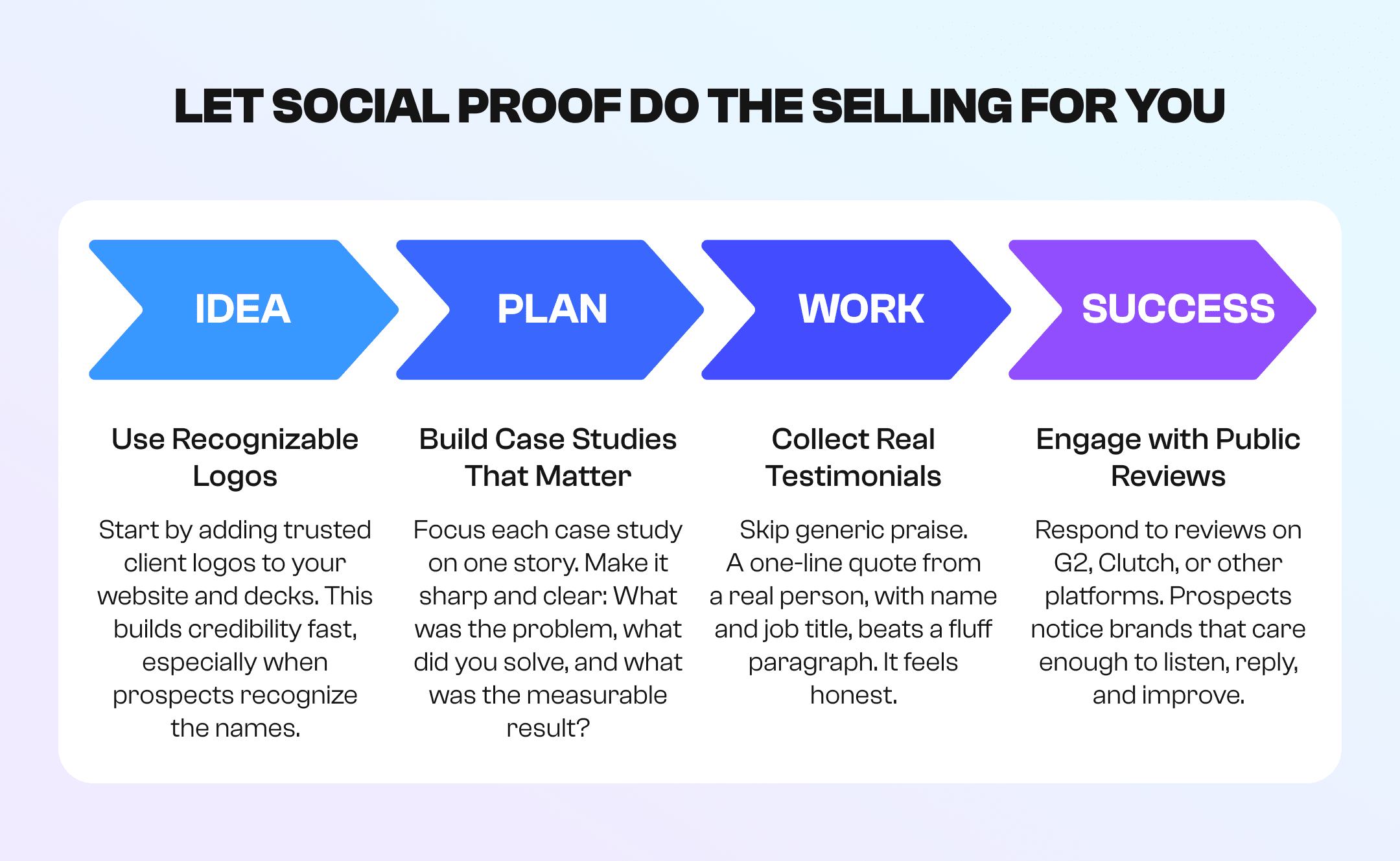
- Use client logos on your website and in pitch decks. They build instant trust, especially if prospects recognize them.
- Create short, focused case studies. Keep them clear: the problem, the solution, and the result (preferably with numbers).
- Ask for direct quotes. A one-line testimonial from a real person, with name and title, is more powerful than a paragraph of polished fluff.
- Respond to public reviews, especially on sites like G2 or Clutch. This shows engagement and care, which buyers notice.
And don’t hide your wins at the bottom of your site. Sprinkle them into your outreach. Drop a line like, “We helped [similar company] cut their onboarding time by 40%—happy to share how.” That kind of sentence gets people curious.
Your happy clients are your best salespeople. Let them speak. Give them the spotlight.
Not all B2B lead generation is created equal. Let’s talk about a strategy that actually delivers qualified leads — not empty promises.
Referrals, Local Wins & Partnerships
If you’re asking yourself how to find sales leads beyond cold outreach, look no further than referrals, local directories, and strategic partnerships.
One of my favorite stories is from a small logistics client—a lean team with a modest budget and no ad spending. We listed them in a regional supply chain directory to boost local visibility. There were no expectations. However, three weeks later, a procurement manager from a Fortune 1000 company booked a meeting.
That lead turned into their biggest deal of the year.
When we asked what led them to reach out, the answer was simple: “We trust vendors listed in that directory. You were the only one who felt relevant.”
There was no elaborate funnel, no perfectly optimized email sequence, just quiet credibility and being in the right place for the right audience.
Most teams overlook this: when it comes to generating leads in sales, referrals and partnerships often outperform paid tactics—not in volume, but in quality and deal size. Best of all, they cost almost nothing.
Referral leads convert better and have a higher lifetime value. That’s not a slight lift—it’s pipeline gold.
Here’s how to build a sustainable system around this:
- Ask for referrals consistently, not occasionally. Timing matters. The best moment? Right after a win. When a client says, “This is working great,” don’t just thank them—say: “I’m glad. Do you know anyone else struggling with the same challenge?” People want to recommend what works. They just need to be asked.
- Use niche directories and associations. Trusted directories and membership lists are high-converting spaces, especially for vertical markets such as logistics, healthcare, and manufacturing. Prospects browse those listings with intent. Be there.
- Build win-win partnerships. Not with competitors, but with adjacent service providers. For example, a CRM company can partner with a lead gen agency, and a payment processor can co-market with an invoicing platform. Think co-branded content, joint webinars, or mutual introductions between client networks.
- Stay top of mind with current clients. If you disappear after the contract’s signed, so do the referrals. Keep them in the loop with feature updates, success stories, or a check-in. Happy clients bring others with them—if they remember you.
Some of our warmest leads didn’t come through a funnel at all. They came from someone’s Slack message, an old client conversation, or a casual mention at an industry event. You can’t always track it, but you can make it happen more often by showing where trust already lives.
So, stop considering referrals as bonus wins and treat them as a core channel. They scale differently, but they do scale.
Score Smart, Sell Better
I worked with a sales team that was stretched thin. They followed up with every lead the same way, with the same effort and urgency. They were burning hours on people who were never going to buy. Frustration was growing. Deals were stalling. Morale was dropping.
So we introduced lead scoring.
We started simple: assigning points based on industry fit, job title, company size, and engagement (opens, clicks, site visits). Suddenly, the picture got clearer. A lead who downloaded a whitepaper, visited the pricing page twice, and matched the Ideal Customer Profile? Hot. Someone from a non-target industry who just opened the email once? It’s likely not worth chasing right now.
Once the team started prioritizing based on those scores, their pipeline got cleaner. They booked more meetings faster—and with better-fit prospects. It didn’t just save time—it made time.
Companies using lead scoring see a 77% increase in lead ROI because it helps generate leads for sales that are ready to convert. That’s almost double the return by focusing on the right people.
Here’s how to get started:
- Set criteria tied to your best customers. What size are they? What industry are they in? What actions did they take before buying?
- Assign points to behaviors. Track email clicks, form fills, demo requests, and page views to determine what signals buying intent.
- Create thresholds. For example, 80+ points = pass to sales. Under 50? Keep nurturing.
- Adjust as you go. Scoring isn’t static. Tweak it based on results and sales feedback.
Not all leads are created equal. Start acting like it. Prioritize the ready ones, and stop wasting energy on the ones that aren’t.
Optimization Is a Habit, Not a Task
We worked with a fintech client with a decent-performing landing page—good enough to keep things moving but not great enough to scale. They wanted more leads and knew their page had potential for generating sales leads, but they weren’t ready to overhaul their site or rebuild their funnel, so we focused on one thing: the headline.
The original version emphasized cost savings. We tested a new one focused on implementation speed—something their ICP deeply cared about. Three weeks later, conversions were up by 22%. Nothing else changed—no design overhaul, no new offer, just a headline that spoke more directly to urgency.
This is what teams miss. Optimization isn’t about huge pivots but consistent, measurable adjustments—the small stuff compounds over time.
So what exactly should you be optimizing? Here’s a more innovative approach:
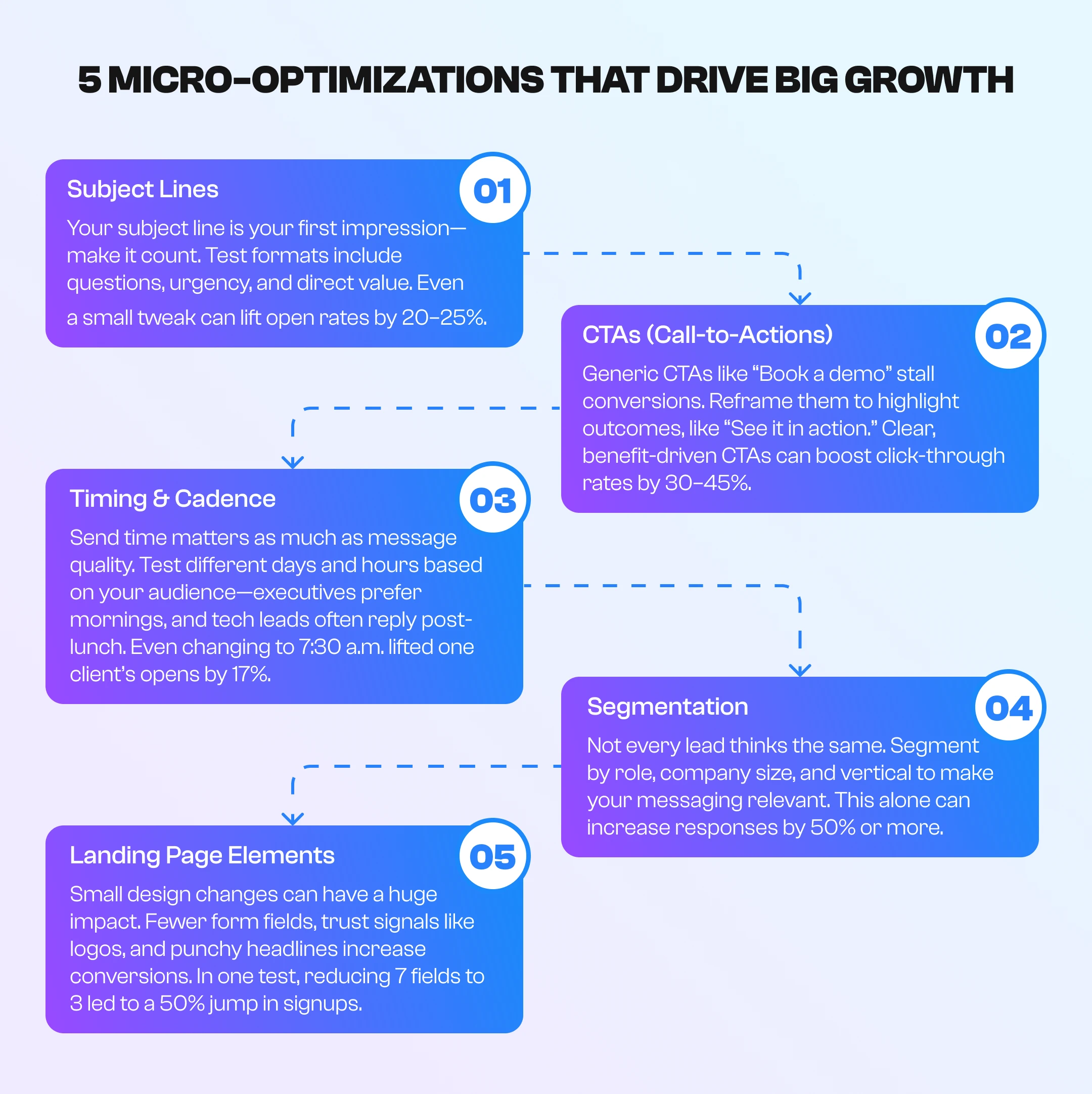
1. Subject Lines
This is your first impression, and it determines whether your message even gets read. According to OptinMonster, 47% of recipients open emails based solely on the subject line. Campaigns have improved open rates by 20–25% by testing different subject formats—questions, urgency, curiosity, and direct benefits. Shorter subject lines often win, especially on mobile, while tone matters more than people think. A casual question like “Quick idea for your sales team?” can easily outperform a formal “Introducing our latest sales solution.” Keep testing until your audience tells you what they notice.
- Subject line testing can improve open rates by up to 25%.
- Short and curiosity-driven lines work well for mobile users.
- Use direct, relevant language tied to the reader’s interest.
2. CTAs (Call-to-Actions)
A strong CTA turns attention into action. Too many companies stick with “Book a demo” or “Learn more”—and then wonder why conversions stall. In one campaign, we changed a CTA from “Schedule a call” to “See it in action”—and click-throughs rose by 38%. It wasn’t a new offer. It was better framing. People respond to low-friction, high-reward phrasing that clearly explains what they’ll get. CTAs should be tested for wording, placement, and clarity.
- Benefit-driven CTAs can increase click-through rates by 30–45%.
- Use action language that sets clear expectations.
- Position your CTA where it’s seen early and often.
3. Timing & Cadence
When you send, it is just as important as what you send. Campaign Monitor reports that Tuesday mornings perform best on average, but industry and audience matter more. Technical buyers often engage after lunch, while execs respond earlier in the day or even on Sundays. In one case, switching email sends to 7:30 a.m. resulted in a 17% lift in open rate. Timing also includes how frequently you reach out. Reducing outreach from six touches to four sometimes improves reply rates by feeling more human and less robotic.
- Send times can impact open rates by 10–20%.
- Test different days and hours by persona.
- Adjust cadence to balance persistence with patience.
4. Segmentation
Segmentation turns average campaigns into high-performing ones. Treating every prospect the same leads to generic results. When we tailored messaging based on role, company size, and vertical, we saw a 50% lift in responses. CFOs care about different things from heads of sales. Startups aren’t thinking like enterprises. You can drastically improve relevance and results by segmenting your list into two or three major groups.
- Segmented campaigns can drive up to 760% more revenue.
- Role-specific messaging improves engagement and reply rates.
- Start simple—divide by role, company size, or product interest.
5. Landing Page Elements
Your landing page is where interest becomes action. Small details can make or break it. We cut the number of form fields from seven to three for one client, and lead submissions jumped by 50%. Even trust signals—like logos, short testimonials, or a client quote—can boost conversions by 30–40%. The trick is to test one element at a time: headline, CTA button, layout, visuals, or form length. Otherwise, you won’t know what worked.
- Shorter forms often lead to significantly higher conversion rates.
- Clear headlines that speak to pain points convert best.
- Trust elements like logos and testimonials build instant credibility.
Set up proper tracking before testing. You don’t need expensive tools—Google Optimize (or VWO, Optimizely, or Unbounce) can do the job. Use heatmaps to see where people drop off. Check scroll depth. Track CTA clicks.
The best-performing teams don’t wait for something to break—they’re constantly improving, always watching, always fine-tuning.
You don’t need to rebuild your strategy every quarter—just refine it every week. The results will come in consistent, compounding wins—the true sign of long-term sales generate success.
Conclusion
If you’ve made it this far, you’re probably looking for something that works, not just once, but repeatedly. And here’s what I’ve learned after managing hundreds of campaigns across industries and regions: generating sales leads isn’t about hacks, tricks, or chasing trends. It’s about being intentional. Consistent. Human.
Every strategy I’ve shared boils down to knowing who you’re talking to, meeting them where they are, and offering real value. Build systems that put people first, not platforms. Don’t just automate touchpoints—make them matter.
Because when you focus on empathy and clarity, everything else follows. Higher conversions. Better meetings. Long-term relationships.
If I could give you just one piece of advice, it’s this: stop chasing clicks. Start building connections. That’s how you generate leads that go somewhere.
No cold outreach, no stress. Just sales-ready calls with decision-makers.

